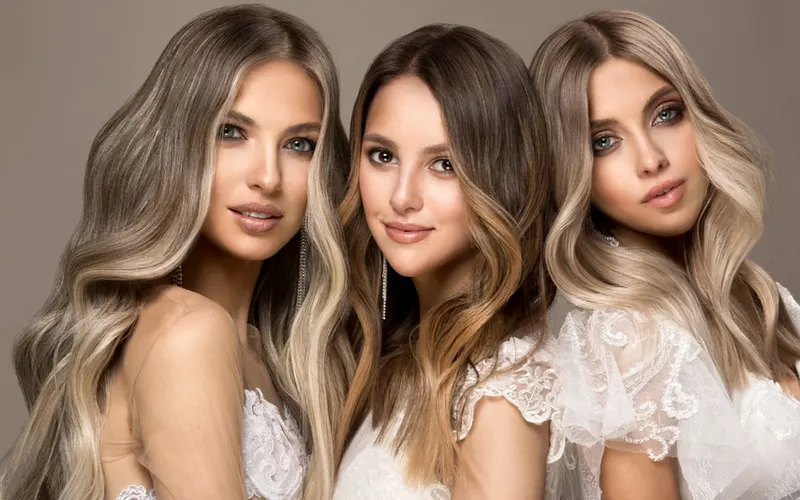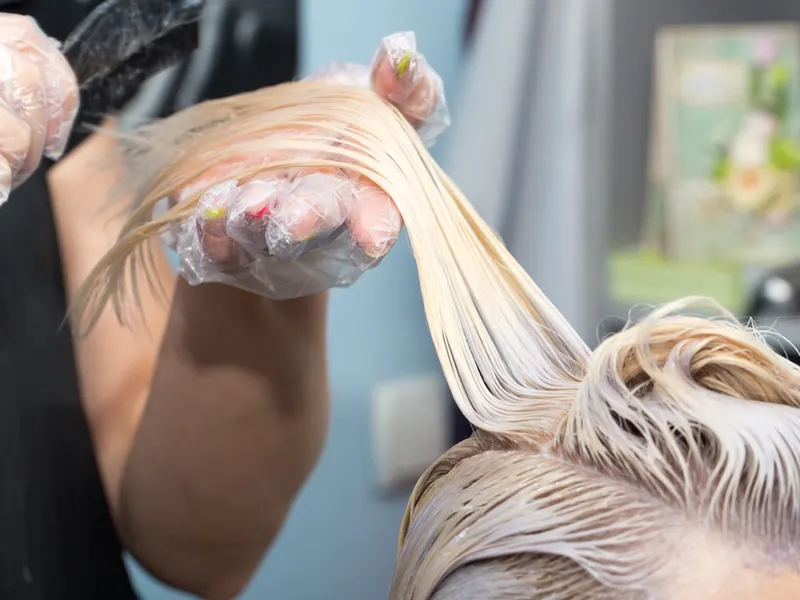Jump to:
Going blonde can be a fun change to make to your look. But it’s not quite as easy as it sounds. After all, the process varies by hair type and color. But don’t worry — you’re in the right place. Keep reading to learn all you need to know.
What Is Blonding?

Hedgehog94/Shutterstock
If you want to take your dark hair light, then it’s time to consider blonding. As the name implies, blonding is the process of dyeing your hair any shade of blonde.
However, it’s not as simple as breaking out a box of dye and heading to the bathroom. Whether it’s honey, platinum, or strawberry, blonding can be a complex process if you’re going from dark to light. Lightening hair poses a lot of challenges.
If you don’t do it right, blonding could leave you with orange, purple, or ashy hair that’s anything but flattering.
That’s why it’s so important to follow the proper steps. That said, going blonde can be a fun experience and give you a striking new look. So, read on to learn everything there is to know about blonding.
Types of Blonding Services

Sofia Zhuravetc/Shutterstock
When you choose to go blonde, you’ll need to decide which method will give you the results you want. So, once you scour the internet and magazines for pictures of your dream dye job, head to your hairdresser and see which option will work best.
Foils
Anyone who’s done highlights in the past will be thoroughly familiar with foils. These shiny strips of paper allow you to put the dye on individual pieces of hair without coloring the surrounding areas.
They’re pretty versatile because they allow your hairdresser to give you subtle streaks or thick, contrasting chunks. Using foils for blonding your hair will give you the potential for a lot of depth.
In addition, your stylist can use varying shades of blonde to give your hair a mix of shades that’ll flatter all your best features. The only thing is that foils require constant upkeep, especially if your natural color is significantly darker.
Babylights
Babylights are a type of highlight that aims for a subtle look. These barely-there highlights are essentially a combination of balayage and standard foil highlights.
They require a lot less upkeep than foils, but your stylist will place them strategically to provide depth, similar to balayage. Plus, they’re flattering for any hair color, skin tone, or face shape.
When your stylist does babylights, they’ll capture very fine sections of hair for highlighting. However, just remember that these small sections ultimately take longer to color, so your trip to the salon could take far longer than what you’re used to.
Ombré
Ombré is a blonding technique that’s easier to maintain than foils and gives you a unique look. Your stylist will dye your hair in shades that blend into each other from the root to the tip.
The roots will be a darker shade and gradually fade into lighter shades down the length of your hair.
A popular blonding ombré option is to start with dirty blonde, then fade into a golden shade, before ending with a pale blonde. It’s a beautiful technique, and if your stylist is experienced, you’ll come out looking great.
Balayage
You might’ve seen balayage pop up as a popular blonding technique in the last several years. Often confused with ombré, a balayage job will also give you graduated colors.
However, it has a slightly more natural look. It’s also very low-maintenance. Whereas even the best ombré will undoubtedly look dyed, a good balayage will maintain the natural appearance of darker roots that turn lighter down the length of your hair.
You’ll likely start with a dark blonde or even light brown at the roots, and then your stylist will hand-paint highlights through your hair.
Read Next: Balayage vs. Highlights
Face-Framing
Face-framing (also called money piece highlights) are a simple technique that can give your hair and face a pretty lift. This is the process of only dyeing the sections of your hair nearest your face. You can do this as part of your regular dye job, or you could lighten just those pieces.
Your stylist will likely use foils for this technique. However, some hairdressers like to do these sections by hand because it gives a more natural look. What’s nice is that it’s a flattering option for almost anyone.
Full Head
Another blonding option is a complete dye job. Although you could do a simple box dye for this technique, it’s still best to go to a professional if you’re doing a significant change.
For example, if you attempt to go platinum when you’re a brunette, you could end up looking pretty ashy or see no change at all.
Your best bet with dyeing your whole head is to visit your hairdresser so they can figure out the best method. For example, if your hair is dark chestnut, you may need a few trips to the salon to get the job done right.
The Rules of Blonding

Schankz/Shutterstock
When it comes to going blonde, there are some fundamental rules you’ll need to follow to maintain your best look.
Commit to the Time and Cost
First and foremost, when you decide to go blonde, you have to commit to the upkeep. This is especially true if your natural color is dark. Your dye job will require constant touch-ups at least every 6-8 weeks, if not sooner.
In addition to the time commitment, you’ll have to adjust to increased styling costs. Not only will you need to visit the salon more frequently, but you’ll also have to adapt to a blonde-friendly hair care routine.
Create a Good Routine
A good hair care routine for dyed blonde hair is an excellent way to prolong the life of your dye job. You’ll be able to hold onto your shade between touch-ups, minimize damage, and prevent the color from fading. One critical step in a good routine is washing your hair less frequently.
It might go against the grain a bit, but washing your hair is the best way to keep your color from fading. If your hair tends to get oily, you can invest in a good dry shampoo that will help keep your hair feeling soft between washes.
Buy the Right Products
Another part of your hair care routine will involve owning the right tools. Many environmental factors can cause your blonde to fade or even change color, including chlorine, pollution, or sunlight.
You’ll want to invest in the right shampoo, conditioner, and styling products. Some of the key products to consider are:
- Color-safe shampoo
- Blonde formulas
- Dry shampoo
- Toner
- Shine spray
These things will help you maintain your shade, prevent brassiness, and give your blonde hair its best look.
Read Next: What Hair Products Should I Use? Quiz
Consult a Professional
As tempting as it might be just to dye your hair at home, it’s best to consult a professional when you’re doing a major color change. They know how to handle taking dark hair to light in a way that minimizes damage.
In addition, if you’ve dyed your hair dark, it’ll require significant lifting before you can dye it blonde.
If you don’t properly lift the color, the blonding won’t take, and you could end up with over-processed lock. And trust us — you don’t want to have to fix gummy hair.
Tips for Blonding
Going blonde can be quite a process, so here are a few tips for blonding your hair the right way.
Compliment Your Skin Tone
You should always focus on complimenting your skin tone when you dye your hair. For example, certain shades of blonde can make you look washed out, especially if you’re naturally fair. Talk with your stylist to figure out the best way to flatter your natural tone and how to avoid an unflattering look.
Read Next: What Color Should I Dye My Hair? Quiz
Give Your Hair Depth
It’s very easy for blonde hair to “look” dyed if you go for a full dye job. A great way to avoid that is to give your hair depth. Highlights, lowlights, ombré, balayage, and face-framing are excellent options for providing a natural look with added dimension.
Take Your Time
In some cases, it might take several trips to the salon to get the color you really want. Whether it’s because your hair is dark, over-processed, or previously dyed, you may have to be patient during the blonding process.
Rinse With Cool Water
The best way to round out your hair washing routine is with a cool rinse. This will seal your hair’s cuticle, which can help minimize fading. Then, all you have to do is run cool water over your hair once you wash your conditioner out, and you’ll be all set.
Use Shine Spray
A blonde’s best styling friend is a bottle of shine spray. This finishing spray will tame any frizzes or flyaways while giving your hair a pretty sheen. In addition, it helps amplify your blonde hair’s natural light-reflecting properties, making it pop.
Read Next: What Is Hair Glaze?
Use a Hair Mask
Since blonding can be pretty damaging to your hair, you should consider using a hair mask to help keep your strands looking and feeling their best. A good hair mask will strengthen your hair, restore critical fibers, and protect your color.
Frequently Asked Questions

Iordani/Shutterstock
Still have questions about blonding? It’s a big step, so it’s completely understandable if you do. Here are the answers to some of the most common blonding questions.
Which lasts longer, balayage or highlights?
Your hair will grow out the same, no matter what blonding technique you use. However, you’ll be able to go longer between touch-ups with a balayage than highlights. This is because highlights have a clear demarcation line at the root, while balayage is more subtle.
What is a level 7 blonde?
Blonde hair is organized in levels. Level seven hair refers to a dark shade of blonde. However, you might also see stylists apply it to brighter shades of auburn or even red.
How long does it take to go from brunette to blonde?
A significant color change like going from brunette to blonde can take several months if you do it right. You could be looking at six months to a year before seeing the final product. However, this is the best way to keep your hair healthy and prevent over-processing.
How many levels can you lift hair in one session?
Lifting your hair level is the process of taking your dyed hair from dark to light. You can lift your hair 2-3 levels in a typical dye session.
Is balayage done with foils?
Balayage is a blonding technique that uses a brush, not foils. Your stylist will hand-paint certain sections of your hair, giving them more control over the color. Usually, they’ll go lighter around your face, on the top layer, and near the ends.
So, What Is Blonding?
Blonding is the process of dyeing your hair blonde. There are many ways you can accomplish true blonding, but your best bet is to consult with a professional. They can help you choose the best shade, method, and style to ensure you leave looking your best.
